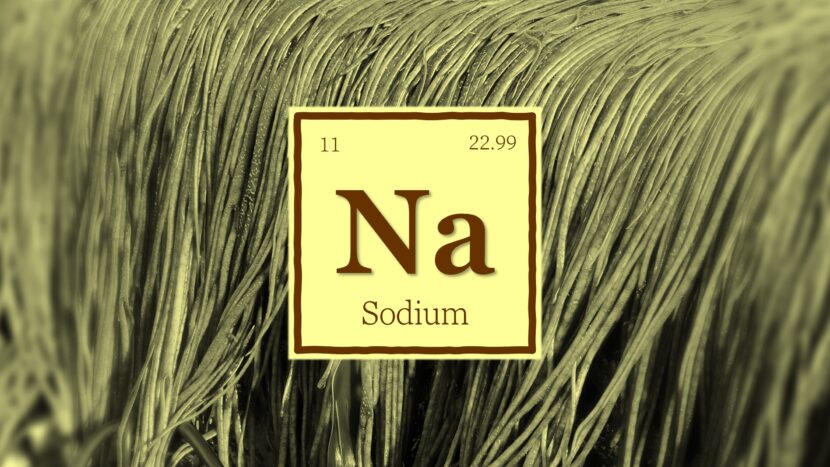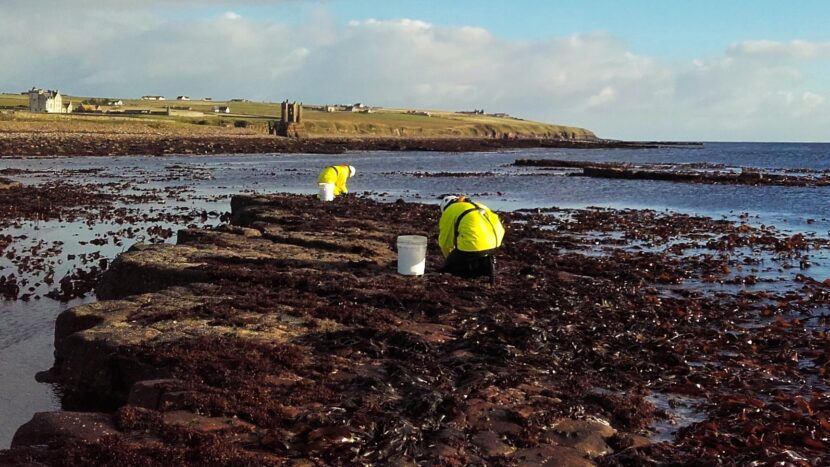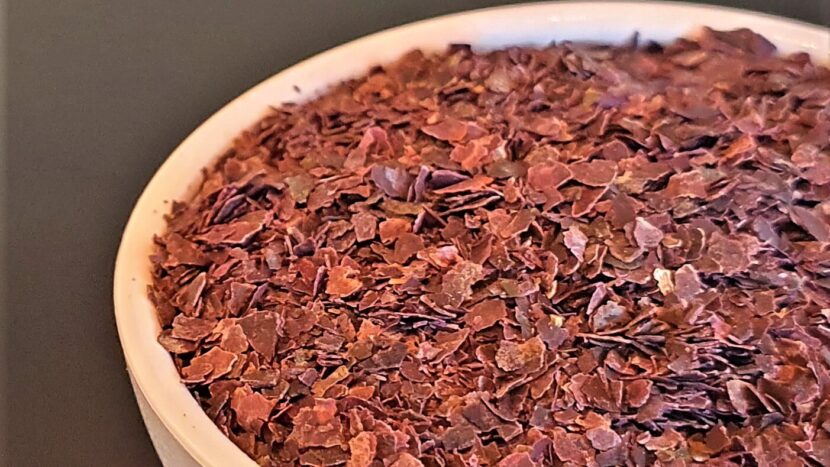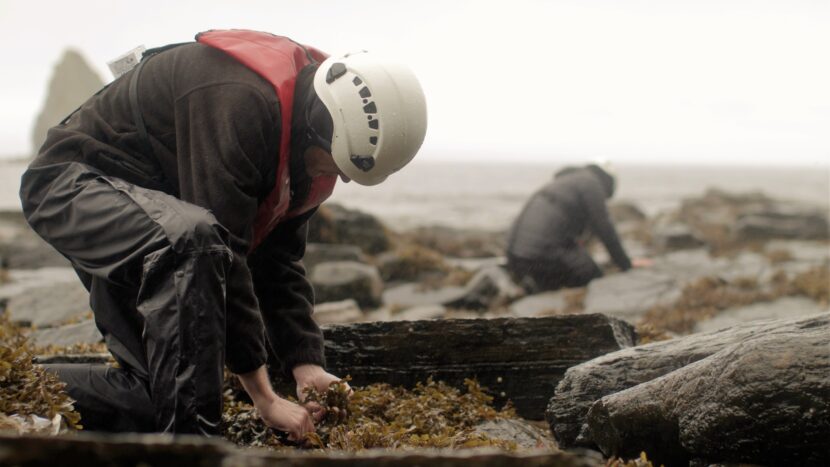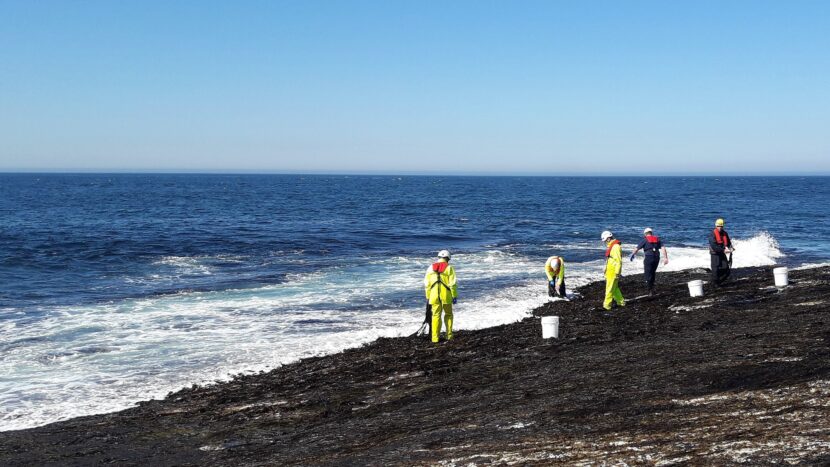Species spotlight: channelled wrack
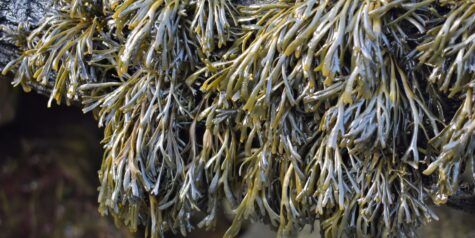
For this article in our Species Spotlight series, our CEO Peter Elbourne shares some of Horizon Seaweed’s insight on channelled wrack. It is an unusual species because it spends very little time underwater. Despite being the first seaweed encountered when walking down a rocky shore, its small size means that channelled wrack is often overlooked. It has an interesting composition that makes it a sensational cosmetic ingredient.
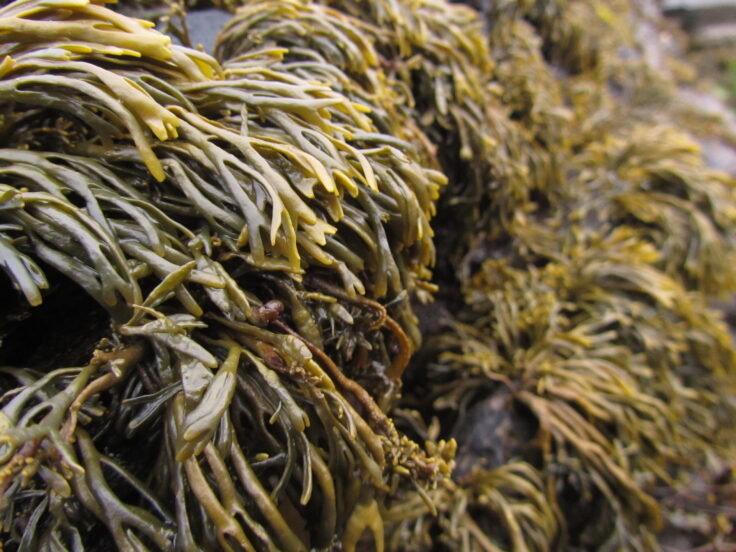
Pelvetia canaliculata – commonly known as channelled wrack – thrives at the top of the shore
An easy seaweed to find at the top of the shore
Channelled wrack is easily recognised because it is the seaweed that grows at the highest point on rocky shorelines around the UK. It attaches with a small holdfast and rarely grows longer than 10-15cm in length. The forked fronds have a gentle curve, giving the species its name (it is interchangeably called channel and channelled wrack). The colour changes during the year, ranging between a deep olive and almost yellow hue, but turning very dark green when dried.
Channelled wrack is from the same part of the family tree as other wracks. Like many marine species, an ever-improving understanding of genetic history has meant that its taxonomy has changed over time. The scientific name is Pelvetia canaliculata, but it used to be Fucus canaliculata and Ascophyllum canaliculata.
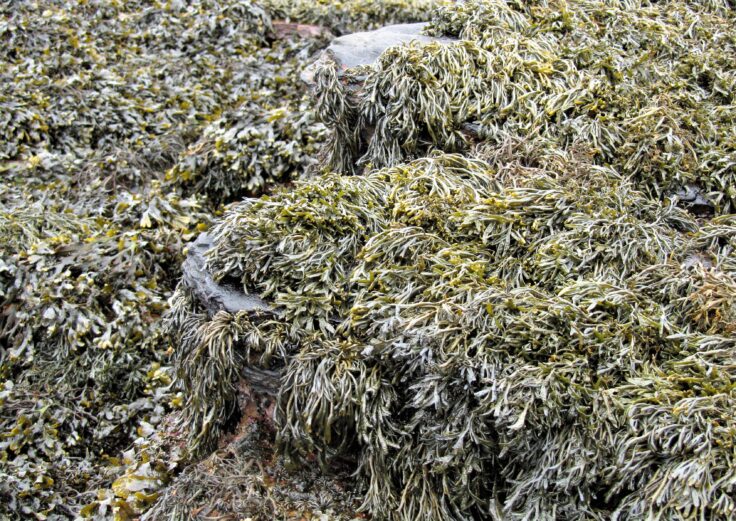
Channelled wrack will thrive in the right conditions, forming a band just above spiral wrack
Zonation is a core theory of marine ecology, with different species forming bands on rocky shores depending on a range of factors. At the top of the shore, the key factor is ability to survive the physical stresses of being exposed to the air at low water. Channelled wrack grows immediately above spiral wrack. Its small size and surface area helps reduce moisture loss through evaporation. Additionally, various chemical components of channelled wrack help, which we will return to later in this article.
Remarkably, a channelled wrack plant will spend perhaps 90% of its life out of water. It will be exposed for nine hours on an average tide, with just a short time in the sea before the tide falls again. On certain tides, some plants may even go a day or two without being covered. Channelled wrack has an astonishing capacity to survive desiccation – the technical term for drying out – and this ability defines its success as a species. One study found it was able to survive out of water for seven days [1]. Astonishingly, it is so well adapted to withstand desiccation that it will die and decay if left underwater for too long: you will not find channelled wrack in a rockpool.
Convergent evolution
Channelled wrack is remarkably similar in size and shape to an unrelated species found on the low shore. Mastocarpus stellatus has lots of common names, including cat’s puff and starweed, but it is usually called false Irish moss because it looks almost identical to its more famous cousin. The distinguishing feature is the curved fronds that are also seen in channelled wrack. While the only obvious difference is colour, these two species belong to completely different biological kingdoms; humans are more closely related to fungi than brown seaweed are to red seaweed. The curved shape is a great example of convergent evolution, where unrelated species develop similar features to help maximise chances of survival. In this case, channels are an adaptation that trap moisture and spread the energy of waves across the seaweed.
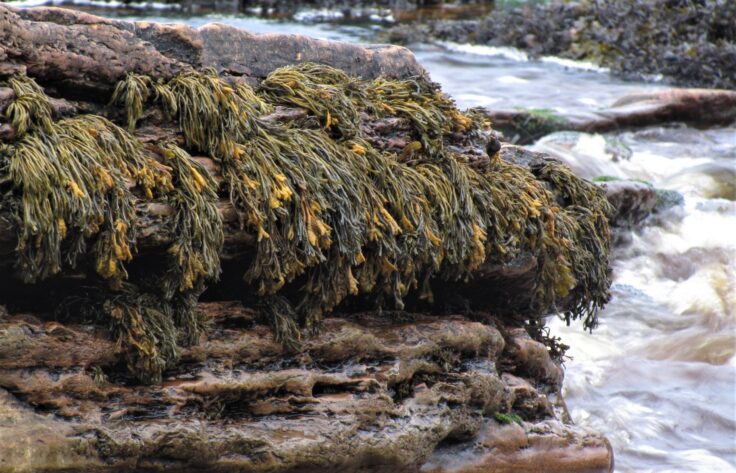
Reproductive bodies are present on the tips of channelled wrack between spring and autumn
Harvesting channelled wrack
Winter is a good time of year to harvest channelled wrack. Reproductive bodies start to form on the tips of the fronds in spring and will typically remain until autumn. Plants will cling to boulders – even pebbles in sheltered conditions. However most of our harvests have been from coastline with rocky shelves, where channelled wrack grows in expansive carpets.
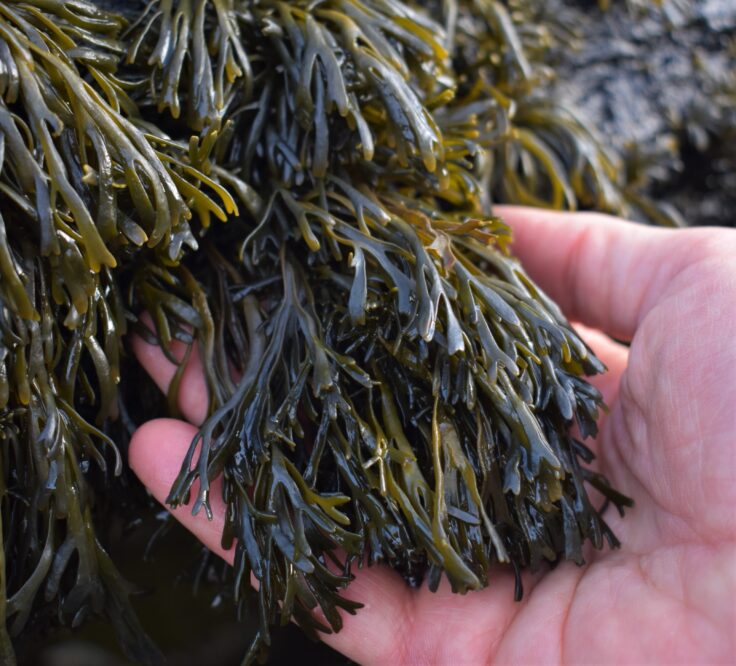
Channelled wrack is a small plant, leading to slower harvest rates compared to related varieties
The harvest season will vary year-to-year as the weather has a significant role in growth and reproduction. We can usually begin picking channelled wrack in late autumn, running through to early spring. It is certainly a species that differs on the north and east coasts of Caithness, most likely connected to water temperature.
The small size of channelled wrack makes it a relatively slow seaweed to pick, but it is usually widespread at the top of the shore. Harvesting on a windy day will often mean that the plants will dry out and be harder to cut. Not only is this tough during the harvest, but also the low weights at the end of the day tend to disappoint!
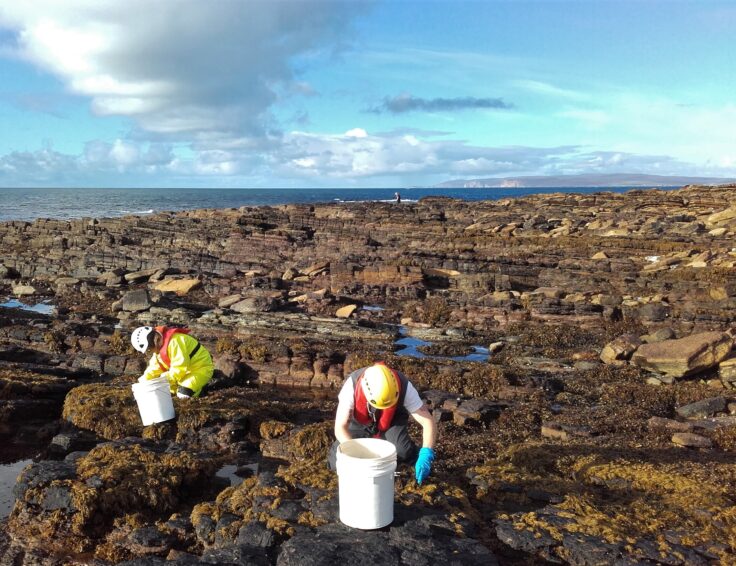
Harvesting channelled wrack on the north coast of Caithness
A good aspect of harvesting channelled wrack comes from its high position on the shore: it can be harvested for at least four hours either side of low water. This long harvest window provides lots of advantages:
- Flexibility in planning, with less stress trying to align to tide times
- Guaranteed low water in daylight hours, even in winter
- Less restriction during adverse weather because waves break far down the shore
- Extended harvest times to maximise intake volume
Overall, the slow picking rates ultimately make channelled wrack a relatively expensive seaweed to harvest. This species holds the record for our longest ever harvest: four and a half hours back in spring 2017.
An unpredictable seaweed to dry
Channelled wrack is certainly an interesting seaweed to process. It has a high average dry yield at 33% (for every 3 fresh kg of seaweed harvested, we expect to get 1 dry kg). This is substantially above all other species we produce: wracks are usually at 20-25%. This helps offset the relatively high harvest cost.

Harvest rates and dry yields vary depending on conditions while the seaweed is exposed at low tide
The position on the shore drives variability in the initial harvest weight, with sunshine, wind and rain all playing a big role. This means it has the most variable dry yield of any species we produce. We would not be surprised to see dry yield for a single batch come out at anywhere between 20% and 50%. Incredibly, one in seven of the batches produced by Horizon Seaweed had a dry yield over 50% - if only all seaweed had such great yields!
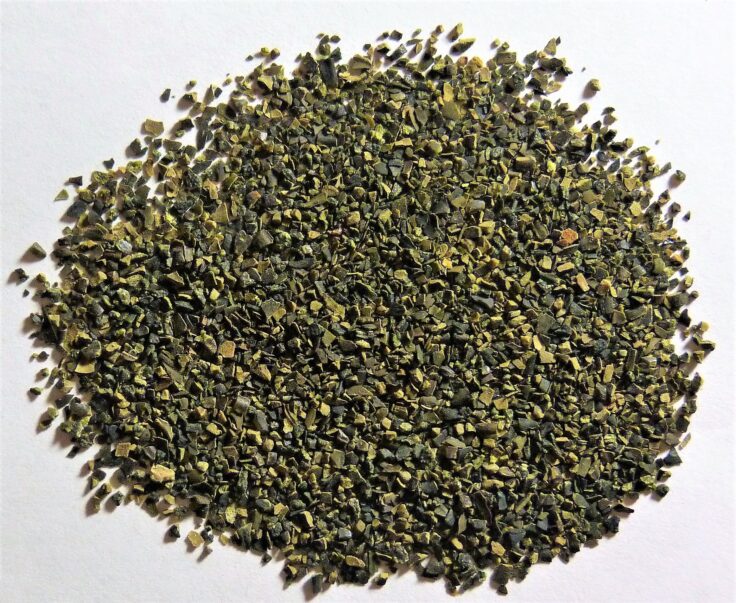
Dried and milled organic channelled wrack produced by Horizon Seaweed
Composition of channelled wrack
There are no remarkable levels of any particular minerals in channelled wrack: they are generally similar to other brown seaweeds. However, channelled wrack has a low iodine content compared to most other species, which is likely to be linked to the minimal time spent under water. The protein content of channelled wrack is relatively low in comparison to other species: red seaweeds tend to be higher, for example.
Complex carbohydrates key to survival
Channelled wrack has one of the highest levels of dietary fibre amongst the varieties supplied by Horizon Seaweed. This is due to the complex carbohydrates that help it survive on the shore. Cellulose is a polysaccharide, a chemical term for a long chain of simple sugars. It is a key structural component of plants and may be one of the most abundant carbon-based polymer on Earth [2]. Channelled wrack has a low content of cellulose compared to other brown algae. This helps the fronds stay flexible on a wave beaten coastline, a property that is also helped by the alginate content. Sulphated fucoidans are another group of complex carbohydrate in seaweeds, built up from molecules of a sugar called fucose. They excel at holding water and help regulate cells when plants are out of the water, which means that channelled wrack has a relatively high content [3].
Research into interesting fatty acid levels
All seaweeds are generally low in fat, but channelled wrack has a relatively high content. Diving into the chemistry, fats – or lipids – are made up of fatty acids that are termed:
- Saturated (if containing no carbon double bonds),
- Monounsaturated (if containing one carbon double bond)
- Polyunsaturated (if containing two or more carbon double bonds).
Saturated fats are deemed to be less healthy and the famous omega-3 and omega-6 fats belong to the polyunsaturated group. Our team worked with the Environmental Research Institute near us in Thurso to investigate the nutritional content of our seaweed, covering 141 batches from eight different species. There was considerable variation between varieties of seaweed, but one of the most interesting results was the fatty acid composition in channelled wrack:
- Highest level of monounsaturated fatty acids, including the top content of oleic acid (found in olive oil)
- Highest levels of omega-6 polyunsaturated fatty acids, including the top content of eicosadienoic acid, dihomo-gamma-linoleic acid and linoleic acid (the latter being one of only two essential fatty acids needed in the human diet).
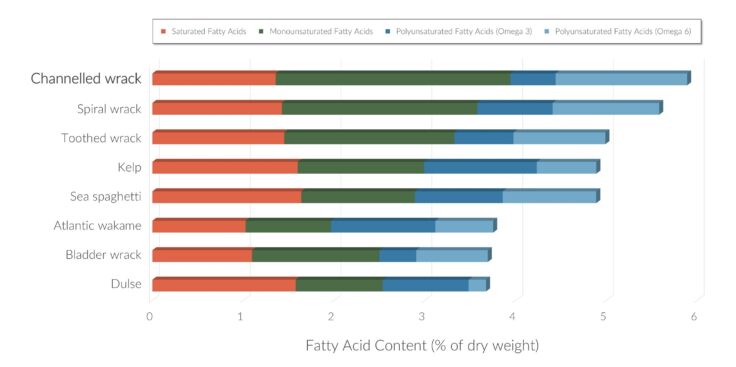
Fatty acid levels in dried channelled wrack produced by Horizon Seaweed: data from Badmus et al. (2022) [4]
The work was part of a PhD studentship and I was a co-author on a paper that published the findings in the journal Food Chemistry in 2022 [4]. The results were similar to a study of Irish seaweed [5]. This demonstrates the value of carrying out detailed analysis of seaweed nutrients and is why we have continually engaged in research projects. Please contact us if you are considering investigating nutrients and remember our archive of seaweed samples are available.
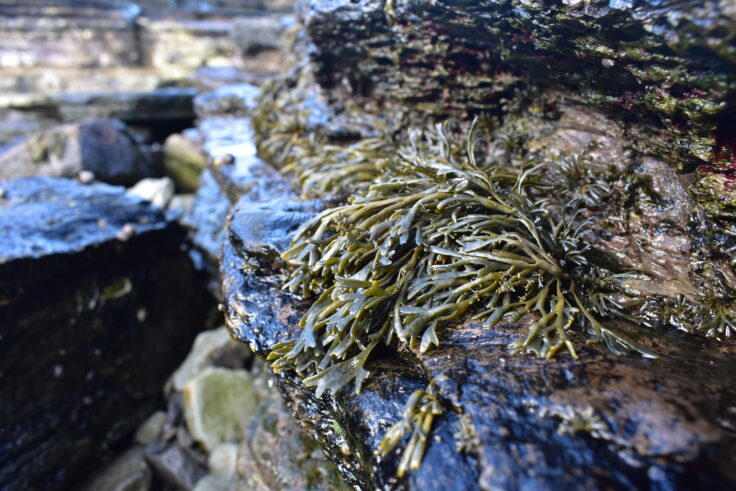
Channelled wrack grows at the very top of the shore, which likely drives its interesting polyphenol and polysaccharide content
Antioxidants
Polyphenols are compounds found in plants that are thought to act as antioxidants. Polyphenol content is relatively high in channelled wrack, but research into our seaweed [4] found lower levels than spiral wrack, bladder wrack and toothed wrack. The amount and type of polyphenols depends on factors such as season, location and processing. Nevertheless, channelled wrack extracts have interesting antioxidant activity, possibly related to the multiple stresses experienced at the top of the shore.
An exciting ingredient for cosmetic applications
One of the main uses of channelled wrack is as a cosmetic ingredient. This is usually in the form of extracts, which will typically use the scientific name of the species: Pelvetia canaliculata. Extracts can be produced using solvents or simply soaking seaweed in water, depending on the intended use. This species is often used in conjunction with other varieties of seaweed: channelled wrack extract and kelp extract are both used in products from Paul Mitchell and Avon.
The high bioactivity of channelled wrack extracts has been linked to the content of polyphenols and polysaccharides. There are various terms used to describe the effects of channelled wrack extracts:
- Regenerating (promotion of cell growth)
- Moisturising (water retention on the skin surface)
- Anti-aging (preserving skin elasticity, reducing wrinkles and boosting collagen production)
Channelled wrack extracts could therefore be suitable for products such as after sun care, hair treatments, face creams and after shaves, but we will leave it to the cosmetic experts to match function to product!

Compounds within channelled wrack are considered to have regenerating, moisturising and anti-ageing properties
An unlikely animal feed
There have been historic uses of channelled wrack as animal feed: one of the common names for this species is cow’s tang. However, this is not a viable application because of the high fibre levels and low protein content. Furthermore, it is a difficult species to scale to the volumes required to achieve a low cost of production. Not only is channelled wrack a small seaweed to pick in the wild, but the slow growth rate and requirement for daily exposure complicates cultivation.
Conclusions
Channelled wrack is an extraordinary seaweed. Its fascinating ability to withstand the harsh conditions on the upper shore leads to an interesting nutritional composition. A comprehensive review of this species by Lalegerie and Stengel was recently published in the Journal of Applied Phycology [6] and is highly recommended for anyone wanting to go into more detail. Please contact us if you would like to source high quality Scottish channelled wrack.
References
1. Pfetzing et al. (2000); 2. Klemm et al. (2005); 3. Kloareg et al. (1986); 4. Badmus et al. (2022); 5. Schmid et al. 2014; 6. Lalegerie and Stengel (2022).
